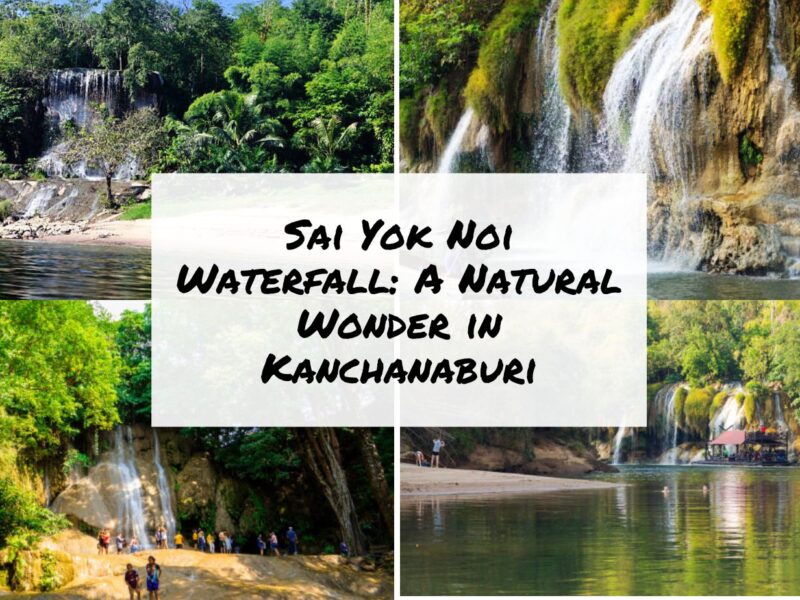Nakhon Si Thammarat is a destination in Thailand that only a select few tourists have experienced. The province may be described as a “white spot” on the tourism map of Thailand because of its prevalence there. A true secret from the inside!
An insider tip that I have been offering to anybody who has ever asked me for travel advice for Thailand over the past few years has been to stay away from the tourist traps.
But why is that exactly? Nakhon is the birthplace of my wife! Nevertheless, we all know that is not the case 😉
Many of the attractions that can be found in other provinces of Thailand may be found in Nakhon Si Thammarat as well. Nevertheless, all at once. Many tourists choose to visit Thailand because of its diverse landscape, which includes mountains, waterfalls, caves, temples, beaches, and many more.
Nakhon Si Thammarat does not have an active nightlife, large commercial complexes, or a well-developed tourism infrastructure. These things are absent from the region.
There are also various guesthouses, motels, and smaller travel companies can be found there. However, on the whole, tourism is still almost non-existent in that region.
In this article, I will give you a quick overview of the province, provide you with three compelling arguments in favor of paying it a visit, and explain how you may travel there.
A brief overview of Nakhon Si Thammarat Province
Nakhon Si Thammarat is a province in southern Thailand that is located on the Gulf Coast. The locals simply refer to the province as Nakhon. Approximately 780 kilometers south of Bangkok. Koh Samui is located just off the coast of Surat Thani, which is the southernmost city in the province. When you are on the beaches in the north of Nakhon, you will get a clear view of Koh Samui.
Nakhon Si Thammarat is a province in Thailand that shares borders with Surat Thani, Krabi, Patthalung, and Trang. The province is made up of 23 districts (counties). The distance to the province capital from Phuket is around 350 kilometers.
Nakhon Si Thammarat, both the city and the surrounding region, held a major place in history and was formerly the capital of the kingdom of Ligor. This kingdom had a civilization that was analogous to that of the more well-known Lanna Empire in northern Thailand. However, this kingdom had its own unique identity. In the late hours, up to the 12th and 13th Nakhon was an important trade center in the 19th century, and it eventually became a vassal state under the Thai dynasties of Sukhothai and, later, Ayuthaya. Nakhon was first absorbed into the Sukhothai empire.
One of the factors that make the city of Nakhon Si Thammarat so important in today’s world is its status as a major marketplace for silver and goldsmith work. However, agriculture also plays a significant role, and the country has enormous acreages dedicated to the production of palm oil, rubber, and fruit.
3 good reasons why Nakhon Si Thammarat is worth a visit
The province is seldom frequented by a large number of tourists, but those who make the “effort” to travel there will be rewarded for their time and energy. In the following paragraphs, I will provide a high-level summary of what is in store for you in Nakhon and the reasons why it is beneficial to make a diversion to this region of Thailand.
Wat Phra Mahathat
The Wat Phra Mahathat Woramaha Viharn, sometimes known simply as Wat Prathat by the people who live in the area, is not only one of the most significant but also one of the oldest temples in Thailand. It is also considered one of the country’s most important temples. (You may get more details on Wikipedia.)
There are not that many temples in Thailand, but Wat Pra Mahathat is exceptional because of the numerous white (partly white-grey due to weathering) chedis surrounding the enormous white chedi that forms the centre of the temple and is 74 metres high.
There is a stairway located in the Viharn Phra Song Ma, which is a temple building that sits just below the huge chedi. This staircase climbs straight up to the chedi. On the other hand, access to this climb is restricted to certain Buddhist occasions. At the time of the celebration that occurs in the tenth month, believers walk around the Chedi three times and then cover it with an orange cloth.
A covered gallery wraps around the compound and is home to a number of Buddha sculptures, the heads of elephants, and the bone of a whale. There is also a fascinating museum on site, which showcases artefacts, coins, and photographs relating to the history of both the temple and the city of Nakhon Si Thammarat.
Location and directions:
It is possible to go to Wat Phra Mahathat from the provincial capital of the same name, Nakhon Si Thammarat, via taxi or public transportation at a low cost and with ease. Wat Phra Mahathat is located in the city of the same name.
Opening hours:
Daily 8am – 5pm
The temple does not charge visitors for entry. In the beginning of October, Ngan Duean Sip, also known as the 10th Month Festival, is held annually.
Khao Luang National Park
Nakhon Si Thammarat Province is home to a number of protected areas that have been designated as national parks. The Khao Luang National Park is both the most well-known and the largest of these parks. The park is named after the peak that is 1835 metres tall and is the highest point in southern Thailand.
The Krung Chin waterfall, which is located in the national park, is widely considered to be among the most breathtaking natural features in all of Thailand. However, a detour to see the Phromlok and Kharom waterfalls is time well spent.
There are several excellent hiking paths in the jungle that are located close to the waterfalls.
At least a three-day excursion is required to scale the tallest mountain in Khao Luang National Park, as well as a few of the park’s other peaks. You will sleep in tents and hammocks throughout this trip.
Location and directions:
The territory protected by Khao Luang National Park extends over a number of the province’s districts (counties). The waterfalls and national parks’ centers are dispersed throughout a somewhat vast region. Therefore, it makes perfect sense to have your own automobile.
The trip to Khao Luang may be planned through the quaint town of Khiriwong, which is well deserving of a day trip and a night’s stay for visitors.
Best travel time:
Ideally, after the end of the rainy season there, which occurs between January and June; this is the time when the roads are dry, but the rivers still carry enough water for the waterfalls.
Additional information may be found on the website of the National Park Administration of Thailand, which is written in English.
Accommodations:
Both in the nearby community of Khiriwong and via the management of the national park, visitors can stay in either a tent or a basic house. You may obtain information on homestay accommodations by calling the Community Center at the following number: (+66) 0 7530 9010
Khanom and Sichon beaches
There are miles of sandy beaches here, but there are hardly any visitors, and you can see one of the most renowned islands in Thailand from here. This is just what you can expect to see on the beaches of Khanom and Sichon, which are located in the northern part of Nakhon Si Thammarat.
Just a few kilometres south of Don Sak Pier, from where ferries sail for Koh Samui and Koh Phangan, lies the district of Khanom, which is the most northern in Nakhon and is located around 100 kilometres from the capital of the province.
The province of Khanom is home to a number of stunning sandy beaches that run on for kilometres. Among them are some of the most well-known beaches, such as Naiplao Beach and Nadan Beach. Because they are the only ones that have been created for tourism, practically all of the available accommodations may be found in these ones.
Despite this, the beaches seem like they’ve been abandoned. It’s likely because the majority of vacationers here are Thai, and Thais don’t much enjoy lounging about on the beach.
There is a population of pink dolphins just off the shore of this area, and visitors may see them while on boat trips.
To the south of Khanom lies the region of Sichon, which is home to a number of beaches, most of which have not been developed. Hin Ngam Beach is located to the south of Sichon, the district’s seat, and is one of the beaches that offers to lodge.
Location and directions:
It is possible to reach Bangkok from either Surat Thani or Nakhon Si Thammarat; in both towns, there is an airport that serves Bangkok, a train station, and of course bus terminals. The distance between Khanom and Sichon is almost the same while travelling from Surat Thani to Nakhon.
Best travel time:
After the conclusion of the monsoon rains, the months of January through June and July are considered to be the finest time to go here.
Accommodations:
The majority of the available lodging choices are located in close proximity to the beaches that have already been described. On this page on Agoda*, you may choose from a variety of different places to stay in Khanom, with prices starting at 340 baht. I am familiar with the Racha Khiri Resort, which is the only five-star hotel in town, but at which I have only had a guided tour. I am also familiar with the Talkoo Beach Resort, which is located directly on the beach and features affordable accommodations that are nonetheless very beautiful.
My experience at the Sichon Cabana in Sichon allows me to recommend it confidently to others. The position is right on the beach, but other than that, there’s scarcely anyone else around. Weekends and Thai holidays are times when the karaoke is at its most boisterous and should be avoided at all costs.
More tips for the (arrival) trip to Nakhon Si Thammarat
Since the travel will necessarily take you through other cities anyhow, visiting Nakhon Si Thammarat is best done in conjunction with other stops or as part of a complete circuit of Thailand.
From Bangkok, travel to the province may be accomplished via plane (one hour), bus (12 hours), or night train (overnight) (approx. 15 hours). There are consistent bus connections to the nation’s capital from the southern region of Thailand, such as from Phuket (five hours) or Krabi (two and a half hours).
From there, one may go to the other locations quickly and simply by taking a cab or one of the local buses.
The tourist industry in Nakhon Si Thammarat is still in its early stages of development. As a consequence of this, there are a few things that the traveller should always be ready for:
- Even in tourist destinations like hotels and resorts, only a tiny fraction of the population is fluent in English. A fundamental understanding of Thai would be really helpful in this situation.
- The selection of western cuisine and Thai dishes that have been altered to appeal to visitors is limited.
- It is not always possible for Western tourists to find accommodations and services that live up to their standards.
- When compared to tourist hotspots, the tolerance for inappropriate clothes in temples is far lower.
- It is inappropriate for ladies or men to be topless or to be away from the beach without their t-shirts.
Interested in traveling to Nakhon Si Thammarat?
One will receive their money’s worth here if they are interested in visiting off-the-beaten-path locations and beaches. Because we have relatives there, I find myself in Nakhon on a very regular basis, and I try to have a positive attitude.
Obviously, only some are capable of going to such locations on their own and organising trips while they’re there. It is to your advantage to have a trustworthy contact person on location who is fluent in both your native tongue and the national language of the country.
- My Caffeinated Journey: The Top 8 Best Coffee Shops in Bangkok - September 11, 2023
- My Encounter with Thailand’s Black and White Striped Snakes - September 2, 2023
- The Koh Samui Island Tour - July 24, 2023


